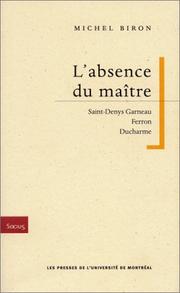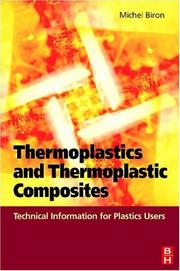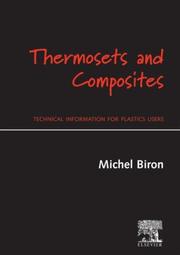| Listing 1 - 10 of 52 | << page >> |
Sort by
|

ISBN: 280400967X 2760616401 9782804009670 Year: 1994 Volume: *138 Publisher: Bruxelles Labor
Abstract | Keywords | Export | Availability | Bookmark
 Loading...
Loading...Choose an application
- Reference Manager
- EndNote
- RefWorks (Direct export to RefWorks)
La littérature doit-elle se constituer en activité autonome ou revendiquer une relation au social ? Telle est la question fondamentale que le Canadien Michel Biron se pose à propos de la littérature belge de langue française.Trois cas illustrent son propos et correspondent à trois époques différentes : Camille Lemonnier, Paul Nougé, Pierre Mertens.
French literature (outside France) --- anno 1800-1999 --- Belgium --- Belgian literature (French) --- Modernism (Literature) --- Belgian fiction (French) --- Belgian poetry (French) --- Littérature belge (française) --- Modernisme (Littérature) --- Roman belge (français) --- Poésie belge (française) --- History and criticism --- Social aspects --- Histoire et critique --- Aspect social --- literatuur --- geschiedenis --- tijdschriften --- sociale geschiedenis --- 19de eeuw --- 20ste eeuw --- België --- 840 <493> --- Franse literatuur: België --- 840 <493> Franse literatuur: België --- Littérature belge (française) --- Modernisme (Littérature) --- Roman belge (français) --- Poésie belge (française) --- sociale geschiedenis. --- 19de eeuw. --- 20ste eeuw. --- België. --- Littérature belge de langue française --- LITTERATURE ET SOCIETE --- BELGIQUE --- Surréalisme --- Symbolisme --- La Jeune Belgique --- Littérature francophone --- Belgique --- Mertens, Pierre --- Hannon, Théodore --- Verheggen, Jean-Pierre --- Lemonnier, Camille --- Eekhoud, Georges
Book
ISBN: 2551044456 9782551044450 Year: 1981 Publisher: Montréal, Québec : Presses de l'Université de Montréal,
Abstract | Keywords | Export | Availability | Bookmark
 Loading...
Loading...Choose an application
- Reference Manager
- EndNote
- RefWorks (Direct export to RefWorks)
Ecrivains quebecois --- Manuscrits --- Bibliotheque nationale du quebec (montreal) --- Catalogues

ISBN: 2760617882 9791036504433 2760623394 9782760617889 2760628760 9782760623392 Year: 2000 Publisher: Montréal Presses de l'Université de Montréal
Abstract | Keywords | Export | Availability | Bookmark
 Loading...
Loading...Choose an application
- Reference Manager
- EndNote
- RefWorks (Direct export to RefWorks)
La modernité québécoise est-elle caractérisée par une absence du maître ? Voilà la question à partir de laquelle sont relues ici les œuvres de Saint-Denys Garneau, de Jacques Ferron et de Réjean Ducharme. Pour y répondre, Michel Biron a lu attentivement leurs principales œuvres à l’aide de la sociocritique des textes et de l’anthropologie. Le concept de « liminarité », ainsi que l’a pensé Victor W. Turner, lui permet de jeter un éclairage nouveau sur ces classiques de la littérature québécoise. Chez eux, les bords sont peuplés, mais le centre, lui, est vide ; cette étonnante géographie suppose des communautés qui ne le sont pas moins. Garneau, Ferron et Ducharme imaginent une société en creux, un espace de communication soumis aux lois de l’amitié plutôt qu’à un système hiérarchisé. La littérature s’offre à eux tel un terrain vague, un « grand loisir » (Ferron) où rien n’est vraiment interdit. À la littérature comme institution et à l’histoire comme série de ruptures, l’écrivain liminaire, qui refuse d’être un « homme de lettres » (Ducharme), oppose l’écriture comme « commencement perpétuel » (Garneau). Il ne se reconnaît plus de maîtres. Mais en a-t-il jamais eus ?
Literature and society --- French-Canadian literature --- History and criticism --- Literature --- Literature and sociology --- Society and literature --- Sociology and literature --- Sociolinguistics --- Social aspects --- Ducharme, Réjean --- Ferron, Jacques --- Garneau, Saint-Denys, --- De Saint-Denys Garneau, Hector, --- De Saint-Denys Garneau, Henri, --- Garneau, Hector de Saint-Denys, --- Garneau, Henri de Saint-Denys, --- Garneau, St.-Denys, --- Saint-Denys-Garneau, --- Plante, Roch --- Criticism and interpretation. --- Littérature québécoise --- Littérature canadienne-française --- Littérature et sociét --- Histoire et critique. --- Ferron, Jacques, --- Ducharme, Réjean, --- Critique et interprétation. --- History and criticism. --- Browning, H. H., --- Literature and society - Québec (Province) --- French-Canadian literature - Quebec (Province) - History and criticism --- French-Canadian literature - 20th century - History and criticism --- poésie --- littérature québecoise
Book
ISBN: 0323480659 0323480667 9780323480666 9780323480659 Year: 2017 Publisher: Amsterdam
Abstract | Keywords | Export | Availability | Bookmark
 Loading...
Loading...Choose an application
- Reference Manager
- EndNote
- RefWorks (Direct export to RefWorks)
Industrial Applications of Renewable Plastics: Environmental, Technological, and Economic Advances provides practical information to help engineers and materials scientists deploy renewable plastics in the plastics market. It explores the uses, possibilities, and problems of renewable plastics and composites to assist in material selection and rejection. The designer’s main problems are examined, along with basic reminders that deal with structures and processing methods that can help those who are generally familiar with metals understand the unique properties of plastic materials. The book offers a candid overview of main issues, including conservation of fossil resources, geopolitical considerations, greenhouse effects, competition with food crops, deforestation, pollution, and disposal of renewable plastics. In addition, an overview of some tools related to sustainability (Life cycle assessments, CO2 emissions, carbon footprint, and more) is provided. The book is an essential resource for engineers and materials scientists involved in material selection, design, manufacturing, molding, fabrication, and other links in the supply chain of plastics. The material contained is of great relevance to many major industries, including automotive and transport, packaging, aeronautics, shipbuilding, industrial and military equipment, electrical and electronics, energy, and more. Provides key, enabling information for engineers and materials scientists looking to increase the use of renewable plastic materials in their work Presents practical guidance to assist in materials selection, processing methods, and applications development, particularly for designers more familiar with other materials, such as metals Includes a candid discussion of the pros and cons of using renewable plastics, considering the technical, economic, legal, and environmental aspects
Plastics. --- Plastics --- Recycling.
Book
ISBN: 1455731250 1455731242 1306156904 9781455731244 Year: 2014 Publisher: Oxford : William Andrew,
Abstract | Keywords | Export | Availability | Bookmark
 Loading...
Loading...Choose an application
- Reference Manager
- EndNote
- RefWorks (Direct export to RefWorks)
This book bridges the technology and business aspects of thermosets, providing a practical guide designed for engineers working in real-world industrial settings. The author explores the criteria for material selection, provides information on material properties for each family of thermosets, and discusses the various processing options for each material type. He explains advantages and disadvantages of using thermosets and composites in comparison to competing materials and assesses cost aspects, enabling the reader to balance out technical and economic constraints when choosing a thermos
Thermosetting plastics. --- Plastics industry and trade. --- Plastic industries --- Chemical industry --- Polymers industry --- Gums and resins, Synthetic --- Plastics
Book
ISBN: 1283716593 1455778982 9781455778980 Year: 2013 Publisher: Amsterdam ; Boston : Elsevier/WA,
Abstract | Keywords | Export | Availability | Bookmark
 Loading...
Loading...Choose an application
- Reference Manager
- EndNote
- RefWorks (Direct export to RefWorks)
This book bridges the technology and business aspects of thermoplastics, providing a guide designed for engineers working in real-world industrial settings. The author explores the criteria for material selection, provides a detailed guide to each family of thermoplastics, and also explains the various processing options for each material type. More than 30 families of thermoplastics are described with information on their advantages and drawbacks, special grades, prices, transformation processes, applications, thermal behaviour, technological properties (tenacit
Thermoplastic composites. --- Thermoplastics. --- Thermoplastics --- Chemical & Materials Engineering --- Engineering & Applied Sciences --- Chemical Engineering --- Chemistry --- Polymers and Plastics --- Gums and resins, Synthetic --- Plastics
Book
ISBN: 0081025025 0081025017 9780081025024 9780081025017 Year: 2018 Publisher: Oxford, England ; Cambridge, Massachusetts : William Andrew,
Abstract | Keywords | Export | Availability | Bookmark
 Loading...
Loading...Choose an application
- Reference Manager
- EndNote
- RefWorks (Direct export to RefWorks)
Thermoplastics. --- Gums and resins, Synthetic --- Plastics --- Thermoplastics

ISBN: 1281049352 9786611049355 008048980X 1856174786 9781856174787 Year: 2007 Publisher: Amsterdam ; Boston : Elsevier/Butterworth-Heinemann,
Abstract | Keywords | Export | Availability | Bookmark
 Loading...
Loading...Choose an application
- Reference Manager
- EndNote
- RefWorks (Direct export to RefWorks)
Thermoplastics represent appx 90% by weight of all plastics consumed world-wide. We know them mainly in the form of polythenes, polyolefins, polystyrenes, nylons and acrylics. Under different heating conditions and by varying the composition of the plastic it is possible to make many different products with differing properties.This is a decision-making tool and source-book of information for plastics users, providing detailed accounts of the materials used, their economics,the selection of appropriate materials, and the use of thermoplastic resins and their composites. By having this
Thermoplastics. --- Chemical Engineering --- Chemical & Materials Engineering --- Engineering & Applied Sciences --- Plastics.
Book
ISBN: 0128215399 9780128215401 0128215402 9780128215395 Year: 2020 Publisher: [S.l.] : William Andrew Publishing,
Abstract | Keywords | Export | Availability | Bookmark
 Loading...
Loading...Choose an application
- Reference Manager
- EndNote
- RefWorks (Direct export to RefWorks)
Plastics --- Environmental aspects. --- Plastic materials --- Plastic products --- Polymers --- Synthetic products --- Condensation products (Chemistry) --- Elastomers --- Plasticity

ISBN: 9781856174114 1856174115 9780080519203 0080519202 9786611048082 1281048089 Year: 2004 Publisher: Oxford ; New York : Elsevier,
Abstract | Keywords | Export | Availability | Bookmark
 Loading...
Loading...Choose an application
- Reference Manager
- EndNote
- RefWorks (Direct export to RefWorks)
A succinct source of information for designers and manufacturers. A decision-making tool for those who need a quick and pragmatic account of thermosets and composites. A synoptic account of the techno-economics and properties of all the commonly-used thermosets and composites. Designers and manufacturers using thermosets and composites, or those intending to do so, often need a succinct source of information on the economics and properties of these materials. This book provides a synoptic approach. It covers the economic importance of thermosets and composites
Thermosetting plastics. --- Plastics industry and trade. --- Plastic industries --- Chemical industry --- Polymers industry --- Gums and resins, Synthetic --- Plastics
| Listing 1 - 10 of 52 | << page >> |
Sort by
|

 Search
Search Feedback
Feedback About UniCat
About UniCat  Help
Help News
News